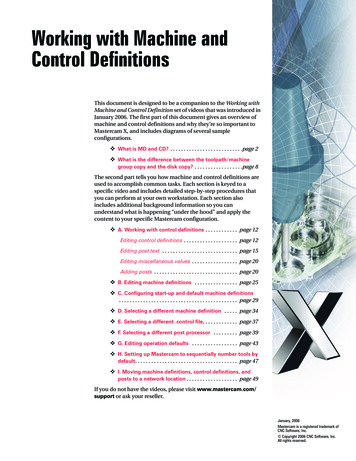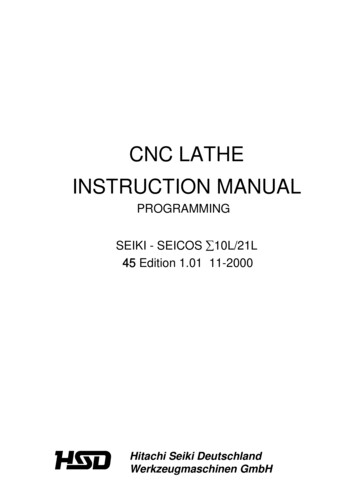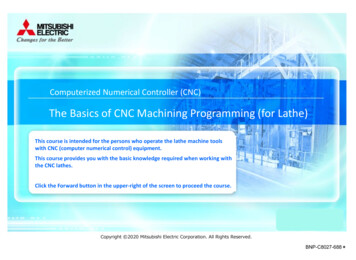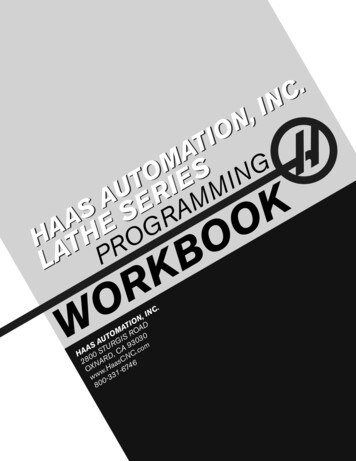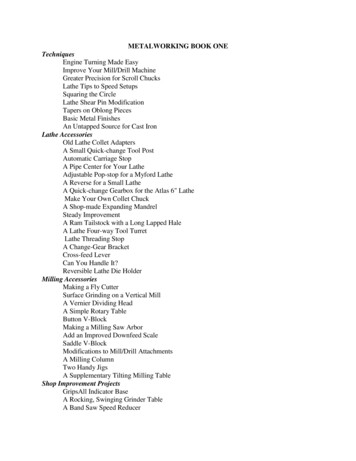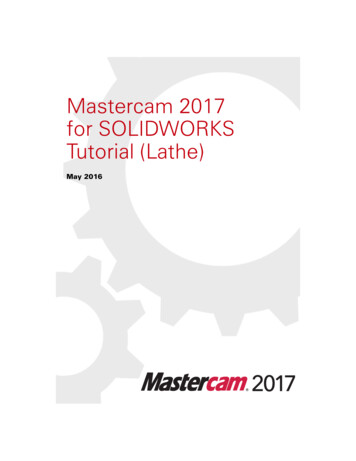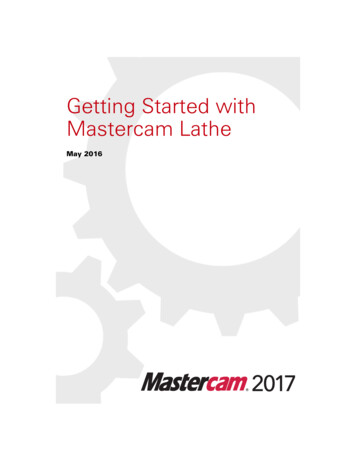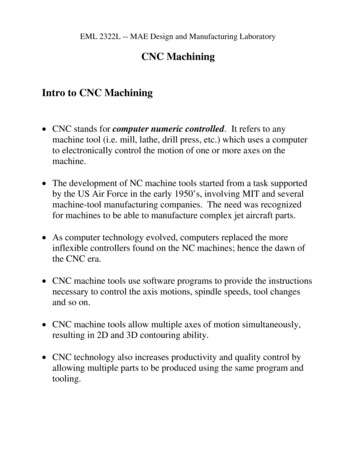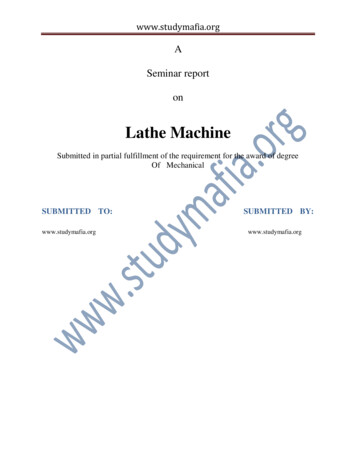
Transcription
www.studymafia.orgASeminar reportonLathe MachineSubmitted in partial fulfillment of the requirement for the award of degreeOf MechanicalSUBMITTED TO:www.studymafia.orgSUBMITTED BY:www.studymafia.org
www.studymafia.orgPrefaceI have made this report file on the topic Lathe Machine have tried my best to elucidate all therelevant detail to the topic to be included in the report. While in the beginning I have tried to givea general view about this topic.My efforts and wholehearted co-corporation of each and everyone has ended on a successfulnote. I express my sincere gratitude to .who assisting me throughout the preparation ofthis topic. I thank him for providing me the reinforcement, confidence and most importantly thetrack for the topic whenever I needed it.
www.studymafia.orgContent IntroductionHISTORYUSESOperations of Lathe MachineParts of the LatheLathe BedHeadstockQuick-Change GearboxCarriageAdvantagesTypesSpecial Types of LathesConclusionReferences
www.studymafia.orgIntroductionLathe is one of the most important machine tools in the metal working industry. A lathe operateson the principle of a rotating work piece and a fixed cutting tool.The cutting tool is feed into the work piece, which rotates about its own axis, causing the workpiece to be formed to the desired shape.Lathe machine is also known as “the mother/father of the entire tool family”.
www.studymafia.orgHISTORYThe lathe machine is one of the oldest and most important machine tools. As early as 1569, woodlathes were in use in France. The lathe machine was adapted to metal cutting in England duringthe Industrial Revolution.Lathe machine also called “Engine Lathe” because the first type of lathe was driven by a steamengine.
www.studymafia.orgUSESWood LathingoThe most traditional use for a lathe is in the field of woodworking. A lathe can beused to shape raw wooden posts into ornate columns, railing supports and tablelegs. An artisan will use a specialized set of knives and gouging tools to shape thewood as it rotates at high speeds on its axis.o There is a danger associated with wood lathing in that choosing a piece of woodwith a hidden knot can sometimes knock the piece of wood loose from the latheor the knife from the hand of the woodworker. Choosing a quality piece of woodfor lathing is therefore a prime safety concern.Metal LathingoMetal lathing has been a key element of the industrial revolution because a latheis needed for creating the common screw, a fastener without which other hightechnology might not exist.o The lathing of metal isn't limited to screw making though; another common use ofthe metal lathe is in making pots and pans. Aluminum is a particularity idealmateriel for lathe shaping items such as pots, as it is relatively malleable,compared to steel and far less expensive than copper. Metal lathes also are used ina plethora of other automated production scenarios.Acrylic LathingoAcrylic ingots can be shaped with a lathe into a variety of useful items, the mostcommon of which are the grips on budget-model hand tools. Acrylic lathing isalso used to shape trophies and awards.o Often times a piece of clear acrylic, or even occasionally other plastics, is cast tocontain a metal figure in the center having something to do with the award inquestion, then spun on a lathe and changed from its cubic shape into a roughsphere. The rough sphere then is polished to make a typical globe trophy.
www.studymafia.orgOperations of Lathe Machine(i) Facing: This operation is almost essential for all works. In this operation, as shown in fig., thework piece is held in the chuck and the facing tool is fed from the center of the work piecetowards the outer surface or from the outer surface to the center, with the help of a cross-slide.(ii) Plane Turning: It is an operation of removing excess amount of material from the surfacethe surface of the cylinder work piece. In this operation, shown in fig., the work is held either inthe chuck or between centers & the longitudinal feed is given to the tool either by hand or power.(iii) Step Turning: It is an operation of producing various steps of different diameters of in thework piece as shown in fig. This operation is carried out in the similar way as plain turning.(iv) Drilling : It is an operation of making a hole in a work piece with the help of a drill. In thiscase as shown in fig., the work piece, by rotating the tail stock hand wheel. The drill is fednormally, into the rotating work piece, by rotating the tail stock hand wheel.
www.studymafia.org(v) Reaming : It is an operation of finishing the previously drilled hole. In the operation asshown in fig., a reamer is held in the tailstock and it is fed into the hole in the similar way as fordrilling.
www.studymafia.orgComponentsThe Headstock ComponentThe upper end of the spindle is held in place and anchored by the headstock on the lathemachine. It also houses the motor that rotates the wood. The way in which you adjust the speedof the spindle is to use a number of pulleys you can find in the back of the headstock. The woodpiece stays in place even while the spindle spins due to a chuck or high-tension spring thatsteadies it.The Tailstock unitA lathe machine is a centered mechanism that is attached to the piece of wood, and that is held inplace by a tailstock. The center can turn with the wood or stay in one place. Within the rotatingdevice or live center are bearings that permit movement.Cutting tools (gauge and chisel), finishing tools and spearDepending on your project and the cutting tool needed, you can choose from differentattachments to your lathe machine. For removing the extra wood we use gauge tool. A skewchisel is utilized to create more intricate carved features. Finer details are made using roundchisels and narrower spears. The wood finishing tools have round edges in order to protect woodfrom slicing.Carriage ComponentThe lathe's cutting tool is steadied by the carriage, giving the craftsmen the freedom to do hiswork. The carriage consists of five different components, which include the compound rest,cross-slide, apron, tool rest and saddle. These components function in conjunction to allow thecutting tool to be used to slide into place.Spindle mechanismThere is a trio of configurations for lathe spindles. The threaded, tapered and cam-lockconfigurations are the three that mainly concern us here. Attaching the chuck to a threaded modelis complex, as the threaded model's configuration is old and the model doesn't have taper Camlock spindles slides into a ring of similar holes and contain cam studs on one end. When you turnthe chuck key, the studs will be locked into place. The third configuration, the tapered spindle,narrows at the tip and has a threaded collar with a built-in chuck key.
www.studymafia.orgAdvantagesAccuracyoThe CNC machine was invented by John T. Parsons in the late-1950s andrevolutionized the manufacturing industry by creating parts with pinpointaccuracy. Because the cutting tools are controlled by a computer, you can within.0001 inches as long as your tooling is sharp and the conditions of the spinningmaterial on the lathe are set to optimize the cutting process. A CNC lathe can cutmany parts before the tooling will need to be change and each one will beidentical.o The only possible errors are related to human interaction. If the program is off orthe tooling is set improperly, damage and inaccuracies can occur. The machinewill only do what it is told through the control unit, so if the material is notproperly set up by a human, the CNC control will not be aware of that fact.SpeedoCNC lathes are not only accurate but can be run very fast. This leads to increasedefficiency and more parts per hour. Humans have limited feed rate ability onmanual lathes. Because CNC lathes often have 12 or more tools in a turret, theycan change to another tool rather quickly.o Most manual lathes have one tool that can be used at a time, severely limiting thespeed of the machining process if more than one tool is necessary to complete thepart. The CNC lathe can also change tools in a fraction of a second and can feedinto the parts fast thanks to power motors seen on modern CNC lathes.Cost EffectivenessoAlthough CNC lathes can cost hundreds of thousands of dollars, their overallspeed and accuracy make them a very cost effective choice, as many operationscan take place within them. Whereas you may need two or three manual lathesand a manual mill to get a part done, you can do all of those operations and morein a well-equipped CNC lathe. This leads to a substantial savings on cost per partover manual machines.o Also, the accuracy contributes to less waste through human error. Your laborcosts may seem higher due to the high cost of trained CNC lathe programmersand machinists, but if you break it down by part, it could be substantially lower.
www.studymafia.orgTypes of Lathes Engine lathe Not production lathe, found in school shops, toolrooms, and job shops Primarily for single piece or short runs Manually operated
www.studymafia.orgSpecial Types of LathesTurret lathe Used when many duplicate parts required Equipped with multisided toolpost (turret) to which several different cutting toolsmounted Employed in given sequenceSingle- and multiple-spindle automatic lathes
www.studymafia.org Six or eight different operations may be performed on many parts at the sametime Will produce parts for as long as requiredTracer lathes Used where a few duplicate parts required Hydraulically operated cross-slide controlled by stylus bearing against round orflat templateConventional/programmable lathe Operated as standard lathe or programmable lathe to automatically repeatmachining operations 2-axis (DRO) so can see exact location of cutting tool and workpiece in X and ZaxesComputerized numerically controlled lathes Cutting-tool movements controlled by computer-controlled program to performsequence of operations automatically
www.studymafia.orgConclusionComputerized Numerical Control (CNC) machining technology is a mouthful, but it is alsofascinating by using computers to create metal parts and products for equipment and machines.In more simple terms, it is high-tech machining technology. Machining and metalworking havebeen developed with computer technology.More efficiency output operations with even greater precision resulted from this marriage ofmachining and computers. In this technology, the hydraulic system is extensively used to controlthe process and drive the machines. So, most of conventional lathe machine are currentlyconverted to CNC lathe machine. The hydraulic circuit is very important for controlling thehydraulic system and describes the functional structure of the hydraulic system.
google.comwww.wikipedia.com
Computerized Numerical Control (CNC) machining technology is a mouthful, but it is also fascinating by using computers to create metal parts and products for equipment and machines. In more simple terms, it is high-tech machining technology. Machining and m
